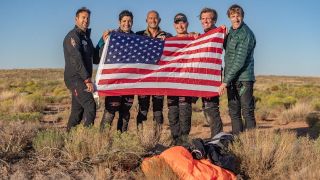Private astronaut Larry Connor etched his name into the record books yet again on Thursday morning (Sept. 28).
Connor — one of the crewmembers on April 2022's Ax-1, the first private astronaut mission to the International Space Station — set a new mark for highest HALO (high altitude, low open) formation skydive on Thursday in the skies over Roswell, New Mexico.
As the word "formation" implies, Connor didn't do it alone. The 73-year-old businessman and adventurer was part of the "Alpha 5" team, which also consisted of four current and former U.S. Air Force (USAF) Special Warfare Pararescue Specialists, known as "PJs."
Related: See amazing photos of SpaceX's Ax-1 private astronaut launch and mission

The five skydivers lifted off aboard a nearly 115-foot-tall (35 meters) balloon — the largest ever manufactured in the United States, according to project team members — from Roswell around sunrise on Thursday morning.
The balloon reached an altitude of 38,000 feet (11,600 m). "From there, the jumpers exited the balloon, and linked arms in a five-person formation before separating and landing roughly 14 miles [22.5 kilometers] east/southeast from the launch site," the Alpha 5 Project wrote in an emailed statement.
That was higher than any previous HALO formation jump, and an observer from Guinness World Records was on site to validate the new mark.
Get the Space.com Newsletter
Breaking space news, the latest updates on rocket launches, skywatching events and more!
"I could not be prouder of the exemplary team behind the Alpha 5 Project that set this world record — including the PJs and technical experts who enabled us to do this safely and successfully," Connor said in the same statement.
"We share this record with each and every person who contributed to the mission. Together, we all did something many thought was impossible, and did it for a great cause," he added.

That cause is educational support for the children of fallen soldiers: The Alpha 5 project aims to raise $1 million for the Special Operations Warrior Foundation (SWOF). As of Friday morning (Sept. 29), Alpha 5 had raised about $26,000 of that goal. All proceeds will go to the SWOF, project team members said.
"The Special Operations Warrior Foundation's enduring promise to America's Army, Navy, Air Force and Marine Corps Special Operations personnel is to honor the fallen, and all Medal of Honor recipients, by providing full educations and additional opportunities, 'cradle to career' (preschool-college), to their children," the SWOF website reads.
HALO jumps have been used by the U.S. military's various special forces for decades, according to the Smithsonian's National Air and Space Museum. They generally occur from an altitude of 30,000 feet to 40,000 feet (9,000 to 12,000 m), with chute opening occurring as low as 800 ft (240 m). That's very different than a recreational skydive, which generally features a jump from no higher than 15,000 ft (4,500 m) and a chute opening at around 3,000 ft (900 m).
HALO jumps "are used for stealth, primarily to bring the jumpers into a hostile region. By keeping the aircraft up high, it can remain out of range of anti-aircraft fire and surface missiles," the National Air and Space Museum wrote.
"While the high altitude brings cover, it also brings substantial danger — lack of oxygen being top among them. If their pressurized equipment fails, it would be a matter of seconds before the HALO jumpers pass out from hypoxia," the organization added.
The Alpha 5 jump team consisted of Connor, who served as team captain; project lead Brandon Daugherty, a USAF Pararescueman; USAF Pararescueman Rob Dieguez; and former USAF Pararescuemen Chris Lais and Jimmy Petrolia. Shane Wallace piloted the balloon and Tad Smith served as oxygen technician.
Editor's note: This story was updated at 10:40 a.m. ET on Sept. 29 with news of the successful jump.
Join our Space Forums to keep talking space on the latest missions, night sky and more! And if you have a news tip, correction or comment, let us know at: community@space.com.

Michael Wall is a Senior Space Writer with Space.com and joined the team in 2010. He primarily covers exoplanets, spaceflight and military space, but has been known to dabble in the space art beat. His book about the search for alien life, "Out There," was published on Nov. 13, 2018. Before becoming a science writer, Michael worked as a herpetologist and wildlife biologist. He has a Ph.D. in evolutionary biology from the University of Sydney, Australia, a bachelor's degree from the University of Arizona, and a graduate certificate in science writing from the University of California, Santa Cruz. To find out what his latest project is, you can follow Michael on Twitter.
